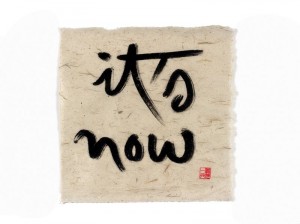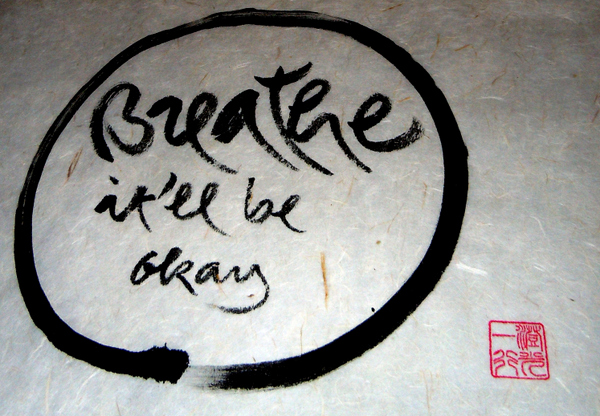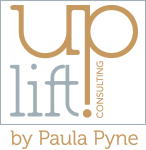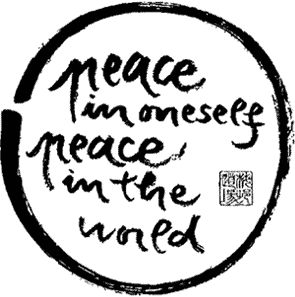First, let’s connect with our breath:
On a deep inhalation repeat silently:
“Breathing in, I know I am breathing in”
On a deep exhale:
“Breathing out, I know I am breathing out”
It begins with me and it begins with you. It begins with the breath, the fuel which ignites our life force. The breath is our starting point. We come back to this beginning again and again. The breath embodies our peace and our ability to remain present. Through our breath, every thought, word, and action joins into the collective consciousness.
Imagine the good we could bring about if our thoughts were driven by peace and fuelled by love?
My heart was warmed by the recent visit of Thich (Thay) Nhat Hanh. Zen Master and spiritual leader, revered throughout the world for his powerful teachings and bestselling works on the art of ‘mindfulness’. His presence this past weekend at the Sony Centre in Toronto lifted and enlightened many; it certainly lifted me, in a very peaceful, quiet way. I’m honoured to share with you some of my insights.
“The Present Moment: Wisdom for Global Peace and Happiness”
Before Thay came on stage, the sold-out Sony Centre came together in silence with an  energetic vibrating presence. Together by way of the breath, we built a warm energy in the room, creating space to receive what was yet to unfold. Listening to Tibetan bells and bowls, a soft soothing voice led us through a mindfulness meditation to connect with the present moment. Imagine.
energetic vibrating presence. Together by way of the breath, we built a warm energy in the room, creating space to receive what was yet to unfold. Listening to Tibetan bells and bowls, a soft soothing voice led us through a mindfulness meditation to connect with the present moment. Imagine.
“Breathing in, I follow my in breath all the way through”
“Breathing out, I follow my out breath all the way through”
“Breathing in, I know I am alive”
“Breathing out, I celebrate that I am alive”
Thay’s message is simple and powerful. It’s a caring request of us very similar to that of the Dalai Lama. Come back home to your body. Stop running.
What are we running from? It’s almost as if we are afraid of ourselves, afraid of finding out what’s underneath the covers, afraid of what happens when we do stop, afraid of the possibility of discomfort, dis-ease, anxiety, and fear. So we run, we get busy, we keep doing. We run to consume more power, money, titles, television, work, social media, shopping, and on and on.
Thay’s message is that we need to stop. We need to stop masking our pain and suffering to engage in the beauty of the present moment. As we learn through the practice of mindfulness, this is where life happens. It happens in every moment, in every breath and mindfulness is what helps us unravel our own beauty and touch the very essence of life.
“Breathing in, I’m aware of my body”
“Breathing out, I celebrate my body”
“Breathing in, I feel calm in my body”
“Breathing out, I release the tension in my body”
There is a great invitation for us to do this now, to come back home to our bodies, to reconcile with who we are and heal our past hurts, to heal our wounded hearts and to let go of what no longer serves us. This needs to happen on an individual level as well as a global one. The world needs healing in a similar way. How we are living isn’t working for us, or mother earth. So what’s the alternative? We need to approach life in a different way, in a caring way.
“Just like the Lotus, we too have the ability to rise from the mud, bloom out of the darkness and radiate into the world.”
~ Unknown Author
For us to experience and live compassionate, peaceful lives, a part of it is, to understand our own suffering, learn how to be with our pain in healthy and constructive ways and to stop trying to mask our hurts and learn to accept that these nuances are part of being human. Suffering and struggle are part of our nature, stemming from of our parents and that of our ancestors. When we learn to accept our hurts, we can stop running and hiding from them.
The way out is to go within, using the tools of mindfulness practice. Thay painted a beautiful picture of how to hold onto and be with our pain through mindfulness. By paying attention to your breath as it enters and leaves your body then without judgement, accept things just the way they are. Mindfulness becomes our mother, wrapping her arms around the pain in us, nurturing our wounds, our hearts. In the vast auditorium, at that very moment, I felt a wave of warmth and peace. I felt peace, a quiet calm that enveloped the room.
Thay and his monastics travel the world offering mindfulness retreats. I have witnessed the gifts of mindfulness through my own experiences and the Uplift clientele, but yet again, touched by his stories. At one of the retreats in Germany, after 5 days of mindfulness training, several men, shared with Thay a reconciliation with their father who they had not spoken to in many years. The conversation began with the courage to call their Father with a calm sense, deep listening and loving speech and it went something like this:
“Dad, I know you have suffered and that I have contributed to your suffering – I didn’t know how to help and I want you to know that I’m here to help. I’m here to listen to your pain, and your story, because I love you.” His Dad wept like a child, on the other line. The man said to Thay, the first thing I’m going to do after the retreat, is to go and see my Father in person.
A big part of my own journey has been to get up close and personal with my shadows – pain, anger, fear — and learn how to love myself through acceptance, self-compassion, and kindness. Mindfulness has helped me discover the road to calm, peace, and happiness.
We don’t have time for anger in today’s fragile world.
The necessary elements here are forgiveness, reconciliation, compassion and loving kindness with ourselves and others, and the creation of space to let go so that we can arrive in the present moment, reconnect with the breath, and BE.
Please join me:
I breathe in, I’m present in my body
I breathe out, I release the past, the future and the projects
As a practice, mindfulness continues to evolve and grow. As you get through each layer and begin to feel anew, you broach new territory. Each time, you learn to greet this newness with grace, building resilience within yourself and creating the capacity to be there for others. It is work but simply put, we don’t need to hold onto baggage. By releasing and letting go of what we have stored in our bodies — mentally, physically, emotionally and spiritually — we give ourselves the permission to feel again, but this time in a different way.
Thay went on to say that this pain is not only your own pain and suffering, it’s that of your parents, your family, and your ancestors. Not long into his talk, he invited us to participate in a chant – to be with and release suffering. I felt as though he created this space in his  heart to hold us, nurturing like a mother holding her child. I imagined a soft voice whispering “it’s okay, darling, to feel what you are feeling, and it’s okay, darling, I know you have suffered, it’s okay to cry”. As each tear ran down my cheek, I mindfully released what needed to leave my body.
heart to hold us, nurturing like a mother holding her child. I imagined a soft voice whispering “it’s okay, darling, to feel what you are feeling, and it’s okay, darling, I know you have suffered, it’s okay to cry”. As each tear ran down my cheek, I mindfully released what needed to leave my body.
These tears were not only mine but the tears of my father, my mother, my sister, my brothers, my husband, my ancestors and perhaps even, the person beside me, in front of me, and behind me. The room was still, filled with a lower energy of pain, yet I felt embraced by voice, by beautiful music, and by the sacred space we had all created.
I am humbled by experiences like this. I am grateful for the practice of mindfulness and reinvigorated with the work that I’m doing through Uplift. I am moved by the peace, serenity, and joy it has brought to my life and honoured to witness the impact it has on others. I am excited by the possibilities of peace that mindfulness brings…and I am thankful for this gift called life.
May all Beings Be at Peace.
Paula
Photo source:
A dear friend, Jenn Hicks, also wrote about the experience – please see Jenn’s post for a summary and other great links and learning from the event. Thank you Jenn!



 Copyright © 2012-2025
Copyright © 2012-2025
Paula, what a gorgeous account of such a beautiful talk. I have been using the breathing meditations to clear my mind and be present. They are so simple, yet so profound.
Thankyou Jenn for your kind words… yes, truly profound and happy to hear!
Pingback: Thich Nhat Hanh | Jenn Hicks Nia in Toronto
Lovely Jenn! And yes, a unique privilege!